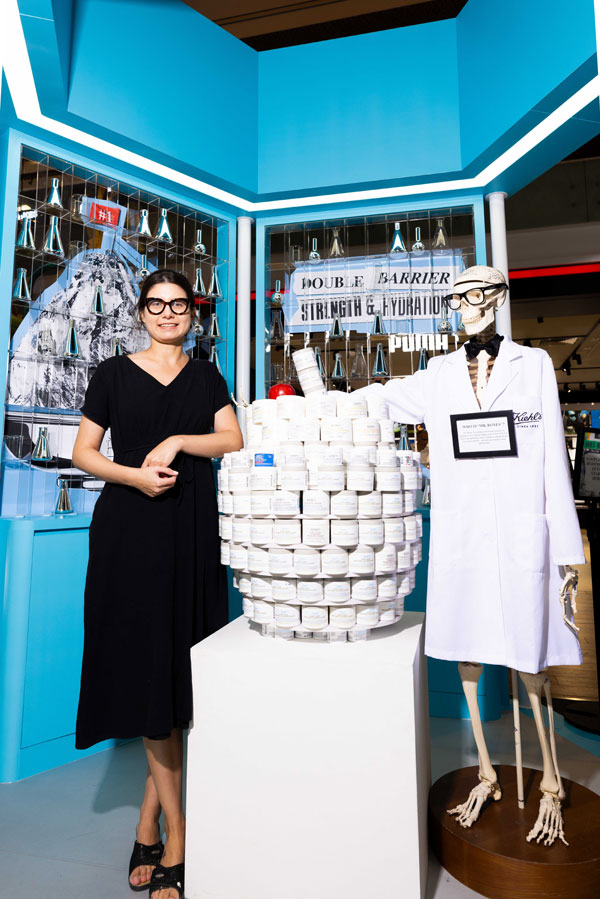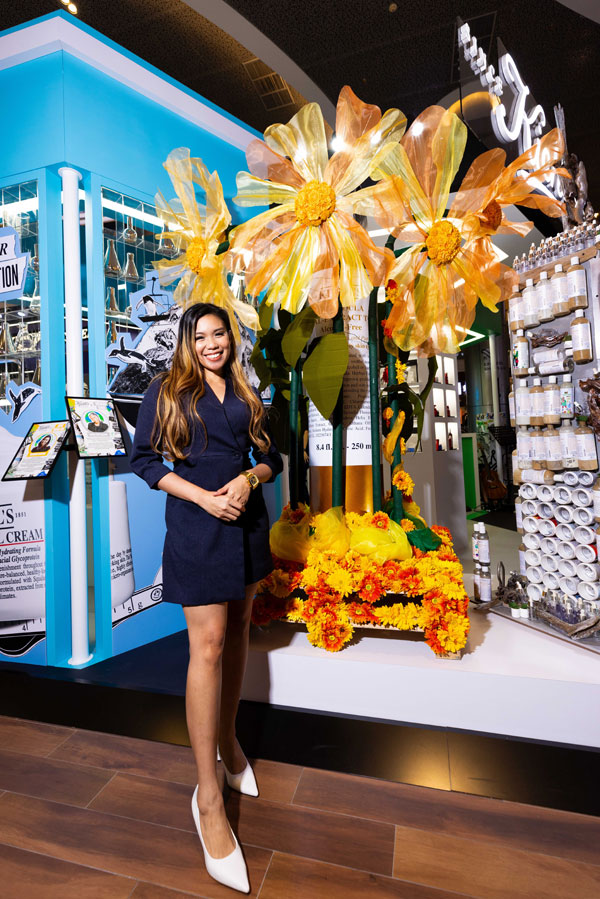
It was a year ago that Kiehl's recreated a New York City Subway station at ION Orchard—complete with musical performances too. The brand makes a return to the very same spot with another Subway-themed pop-up installation, but this time, as a driver to instil the importance of sustainability as well as to highlight its own efforts in the cause.
The Kiehl’s NYC Subway: Trash To Art installation provides visitors with the full-suite of experience one would expect of a typical Kiehl's pop-up. In addition to a range of activities dedicated to educating visitors on key skincare products as well as a personalised skin consultation, the pop-up highlights Kiehl's sustainability efforts which includes its refillable solutions in its skincare, hair and body categories. Like the name suggests, a number of art installations have been crafted from post-consumer materials—mainly Kielh's-related products, of course—such as the "Kiehl's Super Tree" and the "UFC Waterfall". The latter is positioned right above an empties drop-off point that encourages visitors to discard their empty and cleaned beauty empties. The goal is for Kiehl's to reach its target of collecting 60,000 empties for the month of September.
The brand has taken it a step further. A trio of Singaporean artists were commissioned to interpret trash into art that are now displayed as part of Kiehl’s NYC Subway: Trash To Art. In their own words, they share with us more about the process of recreating something out of trash as well as their thoughts on sustainability as part of artistic expressions.

The concept for the artwork was born from my fascination with discovering beauty in overlooked places. I became captivated by the idea of transforming everyday plastic bottles and containers, such as those from Kiehl's products, into a representation of the iconic Empire State Building, symbolising New York and embodying Kiehl's essence. As I worked on the project, it also made me think about how we often overlook the value of things we consider as waste. This led the artwork to take on a deeper meaning, becoming a statement about reusing and repurposing materials.
The primary challenge in creating this artwork was in the cleaning of the interior of the bottles, as there are often residues left. Additionally, sourcing suitable found wood and metals to complement the sculpture presented another hurdle. The journey encompassed everything from achieving cleanliness to meticulously selecting various types of plastic bottles/containers, ranging from Kiehl's products, to incorporate into the artwork. The diverse array of shapes, textures, and colours further contributed to the complexity of the task. Therefore, this creative endeavour wasn't a linear process, but rather one that opened up a multitude of possibilities demanding careful consideration and decision-making.
Seeing beauty in unexpected places is a big part of how I make art. I think there's something special in things that we usually don't notice. This way of thinking doesn't just apply to one artwork—it's in all my creations. I like to make art that surprises people, using different materials or showing things in new ways.
Every artist should think about using sustainable methods because of the current state of the world and environment. Artists possess a unique way of highlighting important issues in ways that make people think. When artists use sustainable methods to make art, they're showing that they care about the Earth. This can inspire others to do the same. It's like being part of a collective effort to stop problems like climate change and waste—even small changes can add up to a big positive impact.
One sustainable skincare hack that I highly recommend is opting for refillable products instead of purchasing new plastic bottles or containers. By opting to buy refills, you significantly decrease the amount of plastic waste generated. This small change not only reduces your environmental footprint but also encourages companies to offer more eco-friendly options.

I was inspired by the nickname of New York being "The Big Apple" which has become an iconic symbol of the city. I utilised old Keihl’s tubs to create "The Big Apple".
Planning the initial outline and working with Sketchup to design each layer of the apple structure were some of the challenges I faced while conceptualising "The Big Apple". I had to calculate the dimensions of each tub and how many would fit per layer in the structure.
I usually work with found materials or upcycle my previous materials into new works. Sustainability is a big factor in the repurposing of discarded materials, turning them into a language for my art practice.
I think that artists are self-aware and have a deep understanding of the way they engage with the environment and the world. Having respect for the way they treat materials and engage with them should be key components of their practice.
I like using water from rinsed rice as a toner for my skin.

My artwork is inspired by the main ingredient of the Calendula Toner, which is the calendula plant. Starting from the base: As a business owner of Chokmah, I do a lot of importing and therefore have accumulated pellets from shippings. The flowers on the base are from a previous Kiehl’s pop up. The stems are made from fabric rolls that were thrown away—I collected them from Chinatown. The strong base for the stem are made from my kid’s formula cans held by an eco-friendly material called jesmonite, a mixture of the remnants from the workshops that I run. The beautiful big petals are made from the offcuts of my photobooths decorations and dance costumes. The big calendula toner is from the decorations of a previous Kiehl’s pop up too—I asked if they had any past "trash" that they wanted to throw away that I could use to integrate into my installation.
One of the challenges I had was, because my installation was going to be a big artwork, worrying if I'd have enough trash to use to construct it. Thankfully, I have a community who believes in sustainability so when I requested for items to be used, there was no lack of it.
Art and education are equally important to me, therefore I believe in educating the community through my art in the hopes that they will be encouraged to also be sustainable in creating their own art.
I encourage every artist to have an element of sustainability in their art forms. But art is subjective; every artist has a different point of view and I respect that too.
Sustainability in skincare is so important to me that I would research on the ingredients used. That is why I love Kiehl’s skincare because the calendula flower petals are now sourced from a hydroponic farm. This system uses 96 per cent less water and 98 per cent less land than conventional farming, and allows the flowers to be harvested in two-month cycles versus the traditional eight-month cycle.
Interview answers have been edited for length and clarity.
The Kiehl’s NYC Subway: Trash To Art pop-up installation is now running until 13 September at B4 Atrium ION Orchard.